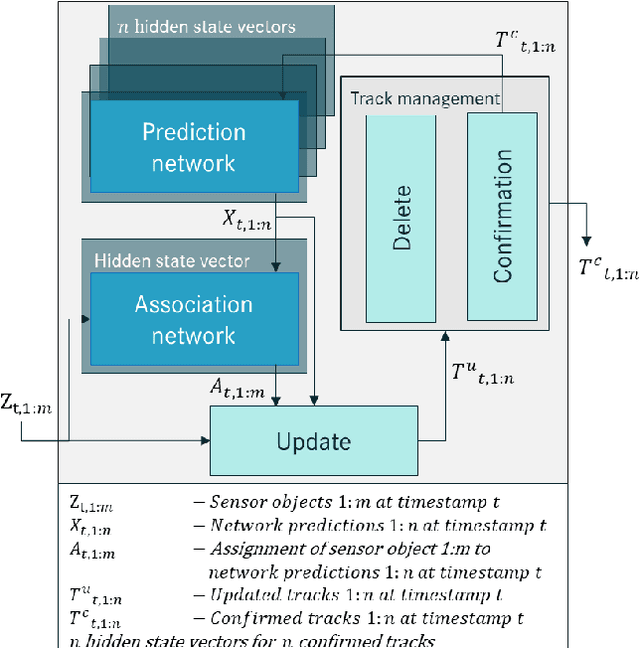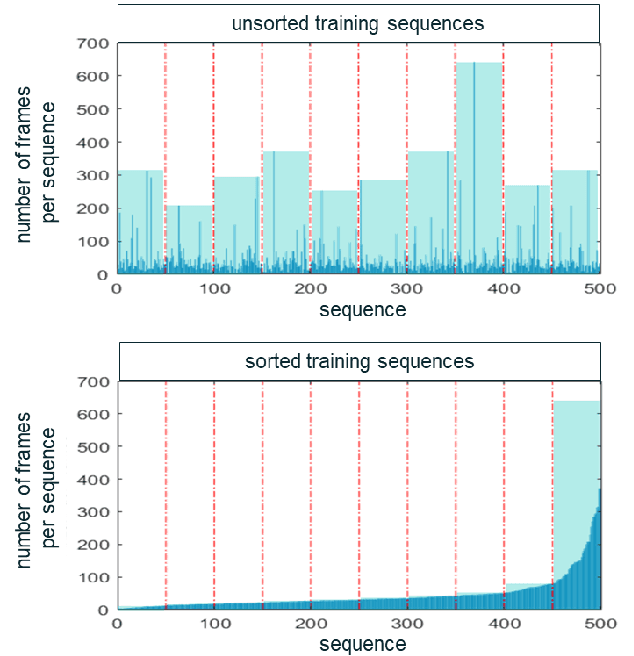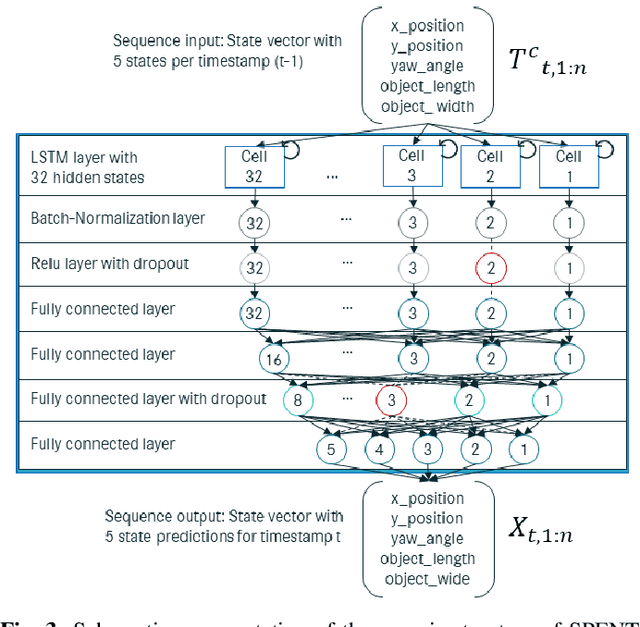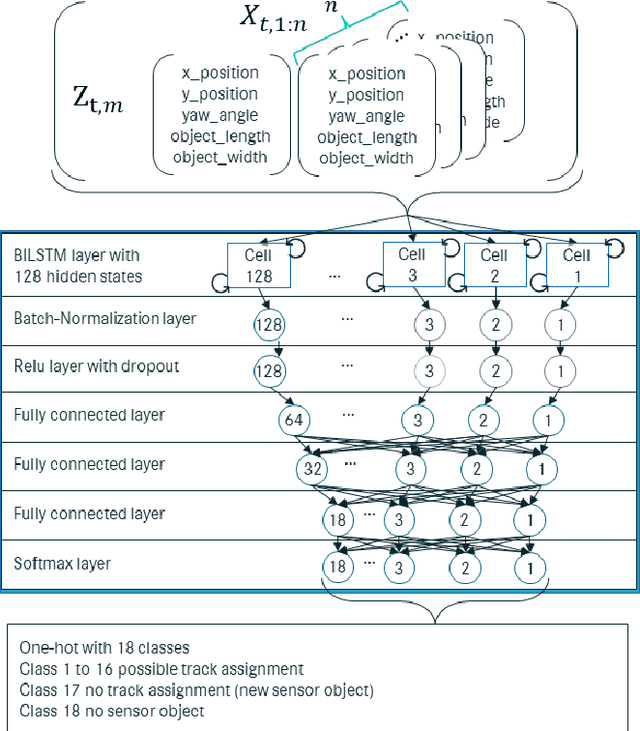Markus Enzweiler
Robust Radar SLAM for Vehicle Parking Applications
Sep 10, 2025Abstract:We address ego-motion estimation for automated parking, where centimeter-level accuracy is crucial due to tight spaces and nearby obstacles. Traditional methods using inertial-measurement units and wheel encoders require calibration, making them costly and time-consuming. To overcome this, we propose a radar-based simultaneous localization and mapping (SLAM) approach that leverages the robustness of radar to adverse weather and support for online calibration. Our robocentric formulation fuses feature positions and Doppler velocities for robust data association and filter convergence. Key contributions include a Doppler-augmented radar SLAM method, multi-radar support and an information-based feature-pruning strategy. Experiments demonstrate high-accuracy localization and improved robustness over state-of-the-art methods, meeting the demands of automated parking.
A Systematic Literature Review on Detecting Software Vulnerabilities with Large Language Models
Jul 30, 2025Abstract:The increasing adoption of Large Language Models (LLMs) in software engineering has sparked interest in their use for software vulnerability detection. However, the rapid development of this field has resulted in a fragmented research landscape, with diverse studies that are difficult to compare due to differences in, e.g., system designs and dataset usage. This fragmentation makes it difficult to obtain a clear overview of the state-of-the-art or compare and categorize studies meaningfully. In this work, we present a comprehensive systematic literature review (SLR) of LLM-based software vulnerability detection. We analyze 227 studies published between January 2020 and June 2025, categorizing them by task formulation, input representation, system architecture, and adaptation techniques. Further, we analyze the datasets used, including their characteristics, vulnerability coverage, and diversity. We present a fine-grained taxonomy of vulnerability detection approaches, identify key limitations, and outline actionable future research opportunities. By providing a structured overview of the field, this review improves transparency and serves as a practical guide for researchers and practitioners aiming to conduct more comparable and reproducible research. We publicly release all artifacts and maintain a living repository of LLM-based software vulnerability detection studies.
StixelNExT++: Lightweight Monocular Scene Segmentation and Representation for Collective Perception
Jul 09, 2025Abstract:This paper presents StixelNExT++, a novel approach to scene representation for monocular perception systems. Building on the established Stixel representation, our method infers 3D Stixels and enhances object segmentation by clustering smaller 3D Stixel units. The approach achieves high compression of scene information while remaining adaptable to point cloud and bird's-eye-view representations. Our lightweight neural network, trained on automatically generated LiDAR-based ground truth, achieves real-time performance with computation times as low as 10 ms per frame. Experimental results on the Waymo dataset demonstrate competitive performance within a 30-meter range, highlighting the potential of StixelNExT++ for collective perception in autonomous systems.
Data-Driven Object Tracking: Integrating Modular Neural Networks into a Kalman Framework
Apr 03, 2025



Abstract:This paper presents novel Machine Learning (ML) methodologies for Multi-Object Tracking (MOT), specifically designed to meet the increasing complexity and precision demands of Advanced Driver Assistance Systems (ADAS). We introduce three Neural Network (NN) models that address key challenges in MOT: (i) the Single-Prediction Network (SPENT) for trajectory prediction, (ii) the Single-Association Network (SANT) for mapping individual Sensor Object (SO) to existing tracks, and (iii) the Multi-Association Network (MANTa) for associating multiple SOs to multiple tracks. These models are seamlessly integrated into a traditional Kalman Filter (KF) framework, maintaining the system's modularity by replacing relevant components without disrupting the overall architecture. Importantly, all three networks are designed to be run in a realtime, embedded environment. Each network contains less than 50k trainable parameters. Our evaluation, conducted on the public KITTI tracking dataset, demonstrates significant improvements in tracking performance. SPENT reduces the Root Mean Square Error (RMSE) by 50% compared to a standard KF, while SANT and MANTa achieve up to 95% accuracy in sensor object-to-track assignments. These results underscore the effectiveness of incorporating task-specific NNs into traditional tracking systems, boosting performance and robustness while preserving modularity, maintainability, and interpretability.
NeRF and Gaussian Splatting SLAM in the Wild
Dec 04, 2024Abstract:Navigating outdoor environments with visual Simultaneous Localization and Mapping (SLAM) systems poses significant challenges due to dynamic scenes, lighting variations, and seasonal changes, requiring robust solutions. While traditional SLAM methods struggle with adaptability, deep learning-based approaches and emerging neural radiance fields as well as Gaussian Splatting-based SLAM methods, offer promising alternatives. However, these methods have primarily been evaluated in controlled indoor environments with stable conditions, leaving a gap in understanding their performance in unstructured and variable outdoor settings. This study addresses this gap by evaluating these methods in natural outdoor environments, focusing on camera tracking accuracy, robustness to environmental factors, and computational efficiency, highlighting distinct trade-offs. Extensive evaluations demonstrate that neural SLAM methods achieve superior robustness, particularly under challenging conditions such as low light, but at a high computational cost. At the same time, traditional methods perform the best across seasons but are highly sensitive to variations in lighting conditions. The code of the benchmark is publicly available at https://github.com/iis-esslingen/nerf-3dgs-benchmark.
ROVER: A Multi-Season Dataset for Visual SLAM
Dec 03, 2024Abstract:Robust Simultaneous Localization and Mapping (SLAM) is a crucial enabler for autonomous navigation in natural, unstructured environments such as parks and gardens. However, these environments present unique challenges for SLAM due to frequent seasonal changes, varying light conditions, and dense vegetation. These factors often degrade the performance of visual SLAM algorithms originally developed for structured urban environments. To address this gap, we present ROVER, a comprehensive benchmark dataset tailored for evaluating visual SLAM algorithms under diverse environmental conditions and spatial configurations. We captured the dataset with a robotic platform equipped with monocular, stereo, and RGB-D cameras, as well as inertial sensors. It covers 39 recordings across five outdoor locations, collected through all seasons and various lighting scenarios, i.e., day, dusk, and night with and without external lighting. With this novel dataset, we evaluate several traditional and deep learning-based SLAM methods and study their performance in diverse challenging conditions. The results demonstrate that while stereo-inertial and RGB-D configurations generally perform better under favorable lighting and moderate vegetation, most SLAM systems perform poorly in low-light and high-vegetation scenarios, particularly during summer and autumn. Our analysis highlights the need for improved adaptability in visual SLAM algorithms for outdoor applications, as current systems struggle with dynamic environmental factors affecting scale, feature extraction, and trajectory consistency. This dataset provides a solid foundation for advancing visual SLAM research in real-world, natural environments, fostering the development of more resilient SLAM systems for long-term outdoor localization and mapping. The dataset and the code of the benchmark are available under https://iis-esslingen.github.io/rover.
Visual-Inertial SLAM for Agricultural Robotics: Benchmarking the Benefits and Computational Costs of Loop Closing
Aug 03, 2024Abstract:Simultaneous Localization and Mapping (SLAM) is essential for mobile robotics, enabling autonomous navigation in dynamic, unstructured outdoor environments without relying on external positioning systems. In agricultural applications, where environmental conditions can be particularly challenging due to variable lighting or weather conditions, Visual-Inertial SLAM has emerged as a potential solution. This paper benchmarks several open-source Visual-Inertial SLAM systems, including ORB-SLAM3, VINS-Fusion, OpenVINS, Kimera, and SVO Pro, to evaluate their performance in agricultural settings. We focus on the impact of loop closing on localization accuracy and computational demands, providing a comprehensive analysis of these systems' effectiveness in real-world environments and especially their application to embedded systems in agricultural robotics. Our contributions further include an assessment of varying frame rates on localization accuracy and computational load. The findings highlight the importance of loop closing in improving localization accuracy while managing computational resources efficiently, offering valuable insights for optimizing Visual-Inertial SLAM systems for practical outdoor applications in mobile robotics.
StixelNExT: Toward Monocular Low-Weight Perception for Object Segmentation and Free Space Detection
Jul 11, 2024



Abstract:In this work, we present a novel approach for general object segmentation from a monocular image, eliminating the need for manually labeled training data and enabling rapid, straightforward training and adaptation with minimal data. Our model initially learns from LiDAR during the training process, which is subsequently removed from the system, allowing it to function solely on monocular imagery. This study leverages the concept of the Stixel-World to recognize a medium level representation of its surroundings. Our network directly predicts a 2D multi-layer Stixel-World and is capable of recognizing and locating multiple, superimposed objects within an image. Due to the scarcity of comparable works, we have divided the capabilities into modules and present a free space detection in our experiments section. Furthermore, we introduce an improved method for generating Stixels from LiDAR data, which we use as ground truth for our network.
The OPNV Data Collection: A Dataset for Infrastructure-Supported Perception Research with Focus on Public Transportation
Jul 11, 2024Abstract:This paper we present our vision and ongoing work for a novel dataset designed to advance research into the interoperability of intelligent vehicles and infrastructure, specifically aimed at enhancing cooperative perception and interaction in the realm of public transportation. Unlike conventional datasets centered on ego-vehicle data, this approach encompasses both a stationary sensor tower and a moving vehicle, each equipped with cameras, LiDARs, and GNSS, while the vehicle additionally includes an inertial navigation system. Our setup features comprehensive calibration and time synchronization, ensuring seamless and accurate sensor data fusion crucial for studying complex, dynamic scenes. Emphasizing public transportation, the dataset targets to include scenes like bus station maneuvers and driving on dedicated bus lanes, reflecting the specifics of small public buses. We introduce the open-source ".4mse" file format for the new dataset, accompanied by a research kit. This kit provides tools such as ego-motion compensation or LiDAR-to-camera projection enabling advanced research on intelligent vehicle-infrastructure integration. Our approach does not include annotations; however, we plan to implement automatically generated labels sourced from state-of-the-art public repositories. Several aspects are still up for discussion, and timely feedback from the community would be greatly appreciated. A sneak preview on one data frame will be available at a Google Colab Notebook. Moreover, we will use the related GitHub Repository to collect remarks and suggestions.
DualAD: Disentangling the Dynamic and Static World for End-to-End Driving
Jun 10, 2024Abstract:State-of-the-art approaches for autonomous driving integrate multiple sub-tasks of the overall driving task into a single pipeline that can be trained in an end-to-end fashion by passing latent representations between the different modules. In contrast to previous approaches that rely on a unified grid to represent the belief state of the scene, we propose dedicated representations to disentangle dynamic agents and static scene elements. This allows us to explicitly compensate for the effect of both ego and object motion between consecutive time steps and to flexibly propagate the belief state through time. Furthermore, dynamic objects can not only attend to the input camera images, but also directly benefit from the inferred static scene structure via a novel dynamic-static cross-attention. Extensive experiments on the challenging nuScenes benchmark demonstrate the benefits of the proposed dual-stream design, especially for modelling highly dynamic agents in the scene, and highlight the improved temporal consistency of our approach. Our method titled DualAD not only outperforms independently trained single-task networks, but also improves over previous state-of-the-art end-to-end models by a large margin on all tasks along the functional chain of driving.
 Add to Chrome
Add to Chrome Add to Firefox
Add to Firefox Add to Edge
Add to Edge